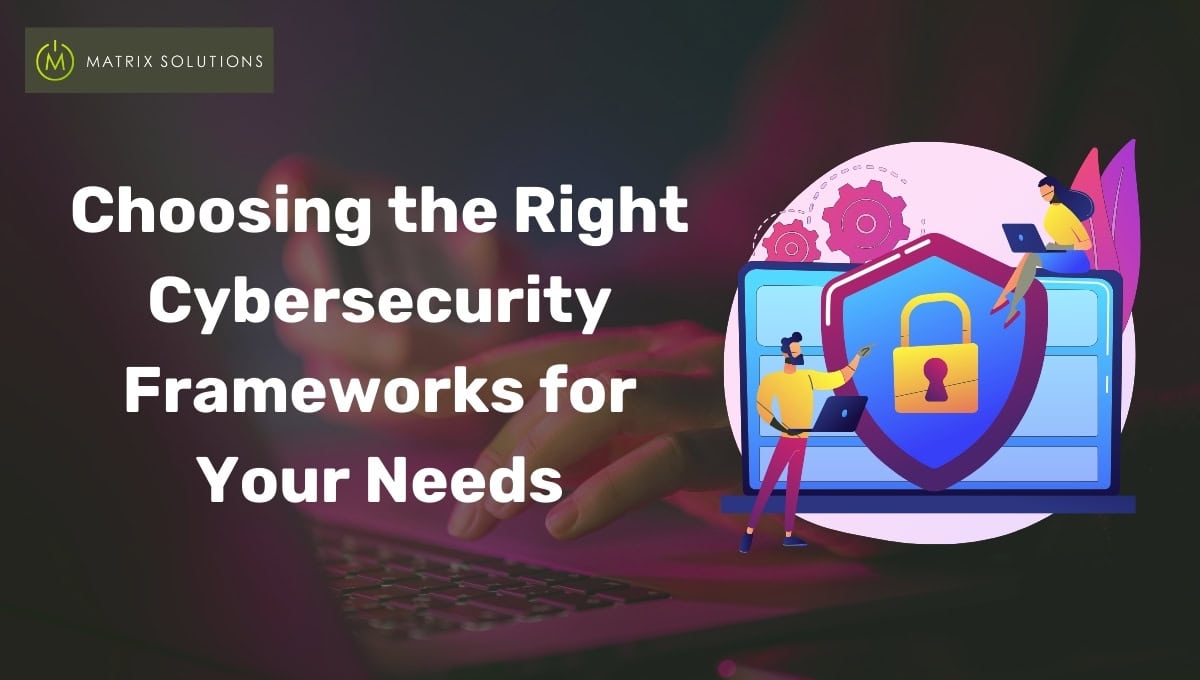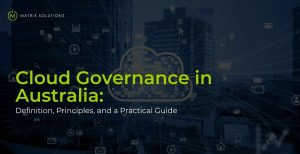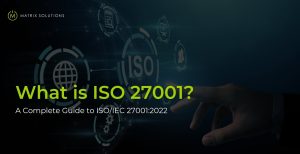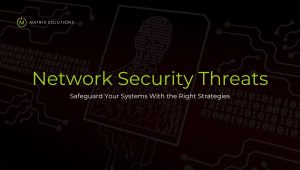Cybersecurity frameworks are essential for any organisation to safeguard its data and IT infrastructure. Whether you’re a small or medium-sized enterprise (SME) or a law firm, selecting the right framework is critical to defend against cyber threats. In Australia, the government faces increasing pressure to strengthen the nation’s cybersecurity, making it important for businesses to adopt a strong strategy. But with so many frameworks available, how do you choose the right one?
Not sure where to begin? Reach out to Matrix Solutions for a free IT services consultation. We’re here to help you find the perfect framework to protect your business.
From the widely recognised NIST (National Institute of Standards and Technology) to industry-specific frameworks like HIPAA (Health Insurance Portability and Accountability Act), these frameworks provide structured guidelines to manage risks and ensure data protection. In this post, we’ll explore seven top frameworks and how they help mitigate risks in the Australian context. Keep reading to discover which cybersecurity framework is best suited for your business.
What is a Cybersecurity Framework?
A cybersecurity framework is a structured set of guidelines and best practices designed to help organisations manage and mitigate cyber risks. These frameworks typically cover various security aspects, such as risk identification, protective measures, detection systems, response protocols and recovery plans.
Importance of a Cybersecurity Framework
Implementing cybersecurity frameworks is vital for several reasons:
- Compliance with Regulations: Many industries in Australia, including finance and healthcare, have strict regulatory requirements regarding data protection. A cybersecurity framework ensures that your organisation complies with these regulations, avoiding costly penalties and reputational damage.
- Minimising Cyber Threats: Cyberattacks are becoming more frequent and sophisticated. A framework helps identify vulnerabilities, mitigate risks and protect against threats, reducing the likelihood of a breach.
- Ensuring Business Continuity: Cyber incidents can disrupt operations and cause significant financial losses. A robust cybersecurity framework prepares businesses to respond quickly and recover from attacks, ensuring minimal downtime.
- Protecting Customer Trust: Data breaches can erode customer trust and damage your organisation’s reputation. A cybersecurity framework demonstrates your commitment to safeguarding sensitive information and fosters trust among clients and partners.
Key Components of a Cybersecurity Framework
Cybersecurity frameworks typically consist of six key functions: govern, identify, protect, detect, respond, and recover. These components provide a comprehensive approach to safeguard crucial information and respond effectively to threats. Below are the core elements of a framework:
- Risk Identification: This function helps assess the risks that could impact your business, allowing you to take proactive measures before any potential threats escalate.
- Protective Measures: These are the steps you take to safeguard your digital assets. Protective measures can include firewalls, encryption, secure authentication processes and employee training on cybersecurity best practices.
- Detection: Tools and strategies for detecting potential breaches or malicious activities within your network are integral to early threat management. Early detection is critical for preventing attacks from escalating and causing significant damage.
- Incident Response: An effective response plan is crucial in the event of a breach. Cybersecurity frameworks provide clear steps for containing the incident, mitigating damage, and restoring security.
- Recovery Plans: After a cyberattack, it’s essential to restore normal operations as quickly as possible. A recovery plan helps rebuild systems, restore data and implement safeguards to prevent future incidents.
7 Best Cybersecurity Frameworks That Help Reduce Cyber Risk in Australia
Information security is a dynamic field that varies across companies depending on their industry, size and operational scope. Many businesses facing increasing cyber threats from nation-state actors must prioritise their cybersecurity resilience.
A 2020 Australian Digital Trust Report revealed that a four-week disruption to critical digital infrastructure could cost the Australian economy AU$30 billion and 163,000 jobs. To help mitigate these risks, we’ve identified seven of the most widely recognised cybersecurity frameworks, each designed to address the specific vulnerabilities and regulatory requirements of businesses across different industries.
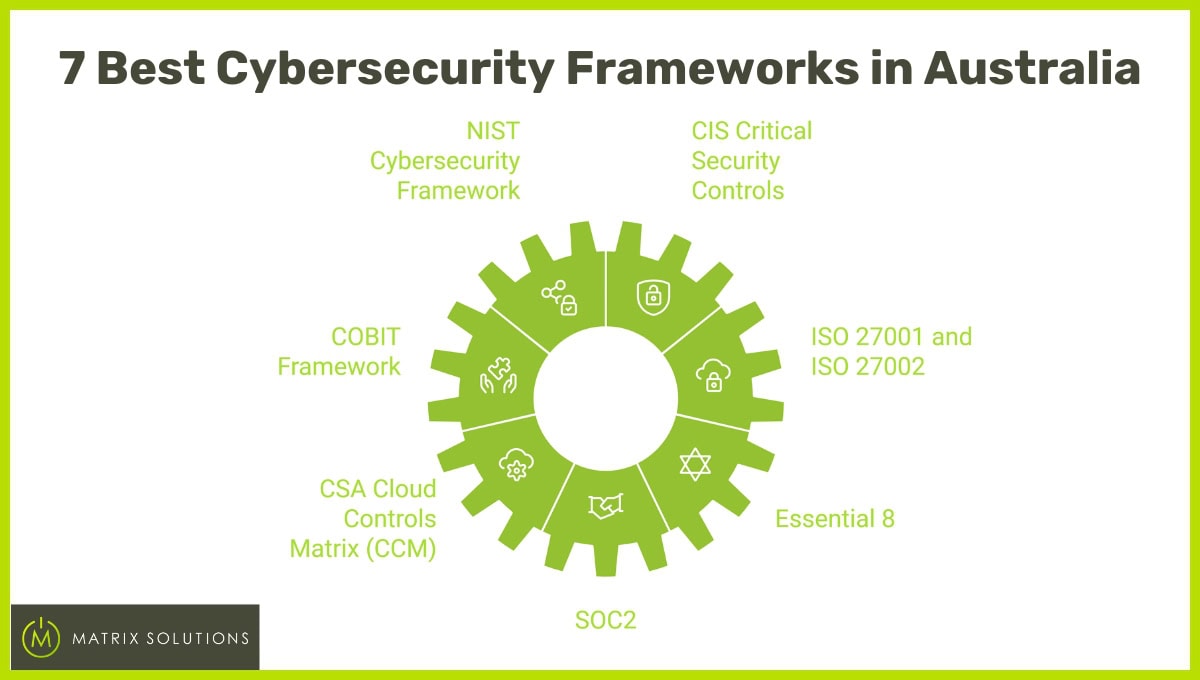
1. NIST Cybersecurity Framework
The NIST Cybersecurity Framework (CSF) was originally developed by the U.S. National Institute of Standards and Technology to provide a structured approach to manage and mitigating cybersecurity risks.
Function:
It is designed around six core functions: Identify, Protect, Detect, Respond, Recover, and Govern. These functions provide organisations with a holistic and adaptable framework to manage cybersecurity risks effectively. NIST has also introduced various resources to facilitate its adoption, including quick-start guides, case studies, and a searchable catalogue of references to align existing practices with the framework’s recommendations.
Why They’re Leading the Way in Australia:
Despite its U.S. origins, the NIST Cybersecurity Framework has gained significant popularity in Australia due to its adaptability and comprehensive guidance. Industries ranging from finance and healthcare to retail and manufacturing can easily tailor the framework to meet local regulatory requirements while benefiting from its globally recognised best practices.
2. CIS Critical Security Controls
The Center for Internet Security (CIS) Control Framework is a comprehensive set of best practices designed to help businesses protect their networks and systems from cyber threats.
Function:
The CIS Critical Security Controls are a set of 20 prioritised best practices that companies can implement to protect themselves from the most common cyber threats. These controls are divided into three categories:
- Basic Controls focus on essential cybersecurity measures that every organisation should implement, such as regular patching, antivirus protection, and secure system configuration.
- Foundational Controls cover more advanced security protocols, such as incorporating two-factor authentication and continuous monitoring of logs for suspicious activity, offering deeper protection against more sophisticated threats.
- Organisational Controls are tailored to the specific needs of an organisation’s environment, emphasising security governance, user awareness, and training programs.
Why They are Popular in Australia:
For many Australian small and medium-sized enterprises (SMEs) with limited IT resources, implementing a full-scale cybersecurity strategy can be challenging. The CIS Controls offer a practical, cost-effective solution by focusing on the most critical areas first, allowing businesses to build their cybersecurity infrastructure incrementally. This makes the framework especially valuable for SMEs, which can improve their security posture over time without overextending their resources.
3. COBIT Framework
The COBIT Framework (Control Objectives for Information and Related Technologies) provides guidelines for data security—including access control, user authentication, encryption, audit logging, and incident response. It was developed by the Information Systems Audit and Control Association (ISACA) to optimise IT resources and align them with business objectives while maintaining a strong focus on cybersecurity and compliance.
Function:
COBIT includes the following key functions:
- Plan & Organise: Developing and aligning strategic IT goals with business objectives.
- Acquire & Implement: Acquiring and deploying IT solutions, including project management and system development.
- Deliver & Support: Manage the delivery of IT services, ensure smooth operations, and resolve incidents.
- Monitor & Evaluate: Continuously monitor and evaluate IT performance, including auditing and security monitoring.
- Manage & Assess: Assessing the effectiveness of IT governance systems, managing risk, and ensuring compliance with laws and regulations.
Why COBIT Excels in Australia:
In Australia, industries such as finance, healthcare, and legal services operate under strict regulatory requirements for data protection and IT governance. The COBIT Framework is particularly useful in helping organisations in these sectors align their IT operations with local regulations while managing cybersecurity risks. By offering a structured, scalable approach to governance, COBIT enables businesses to secure their digital assets, maintain compliance, and mitigate IT risks effectively. Its emphasis on risk management, regulatory alignment, and strong cybersecurity practices makes COBIT an ideal choice for industries with stringent data governance requirements in Australia.
4. ISO 27001 and ISO 27002
ISO 27001 and ISO 27002 are two of the most widely used international standards for information security management, designed to protect data and secure digital environments.
Functions:
ISO 27001: This international standard outlines the requirements for establishing, implementing, maintaining, and continuously improving an Information Security Management System (ISMS). It takes a systematic approach to risk assessment, identifying potential data threats and implementing appropriate controls to mitigate risks. ISO 27001 covers key areas such as asset management, access control, business continuity, and incident response.
ISO 27002: Complementing ISO 27001, this standard provides a more detailed code of practice for implementing specific security controls. It offers guidance on best practices for securing networks, managing sensitive data, and addressing vulnerabilities. Key areas include data encryption, access management, user authentication, and incident response strategies.
Why They are Best in Australia:
Globally recognised, ISO 27001 certification holds particular value for Australian businesses operating internationally or in highly regulated industries like finance, healthcare, and government. Achieving this certification showcases a commitment to maintaining high standards of cybersecurity, helping to build trust with clients, regulatory bodies, and partners.
5. CSA Cloud Controls Matrix (CCM)
The Cloud Security Alliance’s (CSA) Cloud Controls Matrix (CCM) is a comprehensive cybersecurity framework specifically designed to secure cloud computing environments.
Function:
It addresses key areas of cloud security across 16 domains, breaking them down into 133 control objectives.
- Access Control: Ensures that only authorised individuals can access sensitive cloud systems and data.
- User Authentication: Implements secure login mechanisms to verify users’ identity accessing cloud services.
- Encryption: Protects data at rest and in transit through robust encryption methods, ensuring its confidentiality.
- Audit Logging: Tracks system activity and access logs to detect and respond to suspicious activity.
- Incident Response: Provides a framework for detecting, responding to, and mitigating cloud security incidents.
- Mapping to Global Standards: Aligns with prominent security standards and regulations, including ISO/IEC 27001, NIST SP800-53, and HIPAA, facilitating compliance with local and international frameworks.
Why They are Popular in Australia:
Although not mandatory, the CCM is highly beneficial for organisations operating in industries like finance, healthcare, and government, which have strict data protection and regulatory compliance needs. The CCM’s ability to map its controls to mandatory frameworks ensures that businesses can align their cloud security efforts with local regulations. By adopting CCM, companies can efficiently secure their cloud services, ensure compliance with global and local standards, and reduce the complexity of managing cloud security across different platforms. Additionally, cloud providers in Australia can demonstrate compliance by participating in the STAR Registry, enhancing trust and credibility with clients.
6. Essential 8
Developed by the Australian Cyber Security Centre (ACSC), the Essential 8 is a baseline set of eight key strategies designed to mitigate common cyber threats, particularly for Microsoft Windows-based networks.
Function:
The Essential 8 focuses on three core objectives that businesses can recover quickly from a cyber incident. The eight strategies include:
- Application Control: Ensures only approved applications run on systems.
- Patch Applications: Regularly updates applications to fix vulnerabilities.
- Configuring Microsoft Office Macro Settings: Restricts the use of potentially harmful macros.
- User Application Hardening: Disables unnecessary features to reduce the attack surface.
- Restricting Administrative Privileges: Limits admin access to prevent privilege escalation.
- Patching Operating Systems: Regularly updates operating systems to protect against exploits.
- Multi-Factor Authentication (MFA): Adds an extra layer of protection for user access.
- Regular Backups: Ensures data recovery in case of system failure or attack.
Why They are Popular in Australia:
Tailored specifically for the Australian market, the Essential 8 is highly effective for addressing the most common cyber threats faced by Australian businesses. It is especially well-suited for SMEs, offering a practical, cost-effective approach to cybersecurity. The framework can be implemented in stages, allowing organisations to prioritise controls based on their risk profile and gradually strengthen their security posture. This flexibility makes the Essential 8 an ideal choice for businesses seeking a straightforward and efficient way to enhance their cybersecurity.
7. SOC2
Service Organization Control (SOC) Type 2 is a trust-based cybersecurity framework and auditing standard developed by the American Institute of Certified Public Accountants (AICPA). It is designed to help organisations verify that their vendors and partners securely manage client data, ensuring data protection and privacy in third-party services.
Function:
SOC 2 outlines more than 60 compliance requirements across five key trust service principles:
- Security: Protects systems against unauthorised access and breaches.
- Availability: Ensures systems are available for operation as agreed upon.
- Processing Integrity: Confirms that data processing is accurate, timely, and authorised.
- Confidentiality: Ensures sensitive data is protected and shared appropriately.
- Privacy: Addresses the collection, use, and retention of personal information.
Why They are Suitable in Australia:
SOC 2 is especially relevant for businesses in highly regulated sectors, such as finance and banking, which face strict compliance standards. Though challenging to implement due to its comprehensive nature, SOC 2 is a critical framework for any third-party risk management program. Organisations that work with international clients or vendors often find SOC 2 beneficial, as it enhances trust and ensures compliance with global security standards.
How to Choose the Right Cybersecurity Framework?
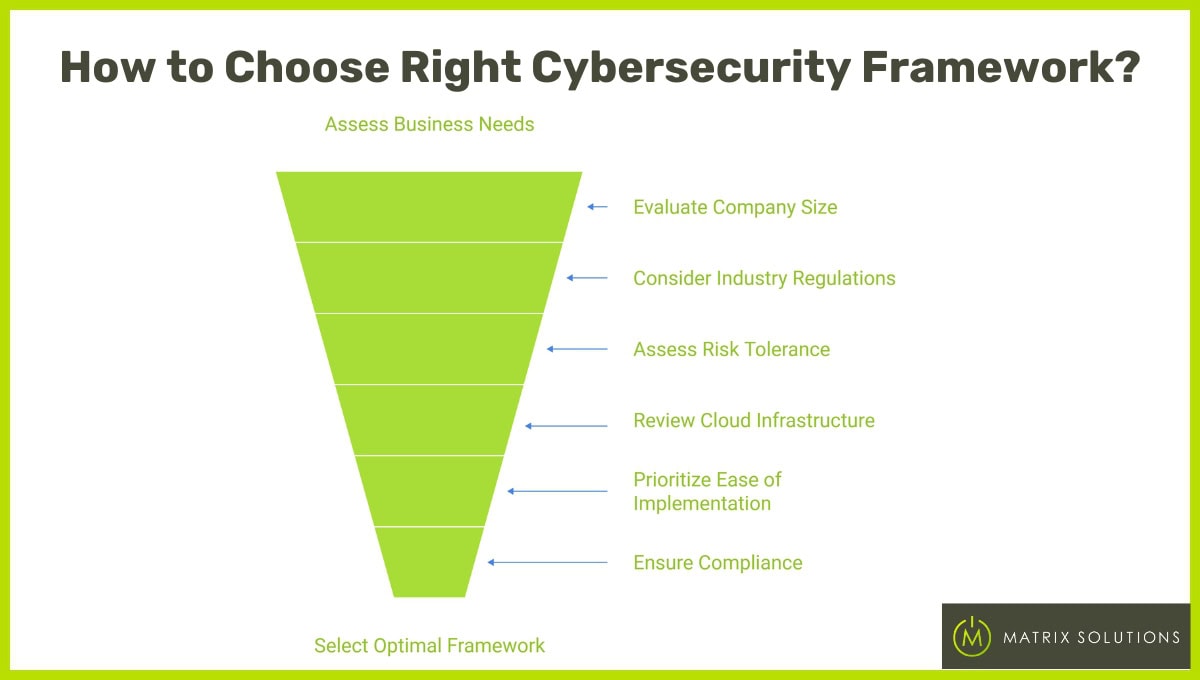
With a wide range of cybersecurity frameworks available, determining the best that suits your needs can be daunting. The decision hinges on several factors, including the size of your company, industry regulations, risk appetite, and existing IT capabilities. Here’s how to make the right choice:
- Assess Your Business Size and Resources
Larger enterprises may require more robust frameworks like NIST or ISO 27001, which offer comprehensive guidelines for managing complex IT systems. On the other hand, smaller businesses or SMEs in Australia may benefit from practical, scalable options such as the Essential 8 or CIS Controls. - Consider Industry-Specific Requirements
Industries like healthcare, finance, and legal in Australia must comply with strict regulations on data protection and privacy. If your business operates in these sectors, frameworks such as COBIT or ISO 27001 might be more suitable, as they are designed to meet rigorous compliance needs. - Evaluate Your Risk Tolerance
Businesses with a low risk threshold—especially those handling sensitive data—should opt for more stringent frameworks with advanced protections and continuous monitoring. Frameworks like NIST or ISO 27001 are ideal for high-risk environments, offering detailed guidance on risk management and incident response. - Review Your Cloud Infrastructure
If cloud computing is a key part of your operations, frameworks like the CSA Cloud Controls Matrix (CCM) provide targeted guidelines for securing cloud environments. With cloud adoption on the rise across Australia, protecting your cloud infrastructure should be a top priority. - Prioritise Ease of Implementation
Some cybersecurity frameworks are simpler to implement than others. If your company is in the early stages of developing a cybersecurity strategy, frameworks like the CIS Controls or Essential 8 offer an accessible starting point, providing actionable, straightforward steps that can scale over time. - Ensure Compliance with Australian Regulations
Choose a framework that aligns with local compliance needs. The Essential 8, developed for the Australian market, follows the Australian Cyber Security Centre (ACSC) recommendations. Likewise, ISO and NIST frameworks are recognised by Australian regulatory bodies, making them ideal for companies that need to meet local legal standards. - Scalability for Future Growth
Your cybersecurity framework should be adaptable and scalable as your business expands. NIST and COBIT are particularly flexible, evolving alongside your business to ensure your security measures continue to meet the needs of your growing IT infrastructure.
At Matrix Solutions, we specialise in guiding businesses through the complexities of cybersecurity. Our team provides customised solutions based on leading industry frameworks, helping you secure your operations and build trust with your clients. Contact us today to discover how we can assist in selecting and implementing the ideal cybersecurity framework to protect your business and customers.


